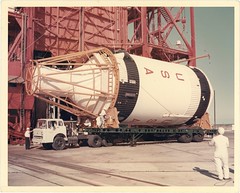
Further reinforcing my perpetual confusion of space shuttle concept identifications during the late 60’s - mid 70’s, there’s this.
I’m pretty sure this design is referred to as “MSC 040A”. Possibly during/under Phase-B’? - with not two, not three, but 4, count ‘em, FOUR main engines - AND bulging ‘canopy’.
Who knew?!
As if that wasn’t enough, I think subsequent(?) to this, design “MSC 042A“ featured ZERO main engines…sort of a pre-Buran Buran design. And, get this, riding atop an uprated Titan IIIL-6 (apparently with 6 strap-on SRBs).
I don’t even know what that is!
The information is out there, to a degree, in bits & pieces & all over the place. Unfortunately, it’s inducing exponentially increasing ass-pain finding/confirming accurate information.
Fortunately, in this instance:
“…Though the issue of payload size and weight was still open, the basic design of the orbiter was approaching a definitive form. During the fall of 1971, when the Mark I/Mark II approach was still in the forefront, the contractors had worked from a Max Faget configuration known as MSC-040A. It elaborated the earlier MSC-040 by adding small liquid-fuel engines for orbital maneuvers, along with thrusters for attitude control that were mounted at the tips of the wings and tail.
The Mark I/Mark II concept, however, with its phased technology, had never been more than an artificial stratagem to reduce peak funding by stretching out the development, while accepting serious compromises in design. With Shultz’s support, NASA now was free to build an honest orbiter, one that would be right the first time. MSC-040A had called for four J-2S engines; a variant of January 1972, MSC-040C, replaced them with three SSMEs…”
At:
history.nasa.gov/SP-4221/ch9.htm
Also, always excellent:
www.capcomespace.net/dossiers/espace_US/shuttle/index.htm
Specifically:
mirrors.josefsipek.net/www.capcomespace.net/dossiers/espa...
Credit: CAPCOM ESPACE website (mirror)
Finally, what’s most important, a beautiful work, unfortunately by an unidentified artist, wonderfully exemplifying the evolution of designs, as evidenced below. In this, I’m amused not only by the slightly undersized nozzle of the upper right engine, but also the detail of the aft bulkhead/base heat shield, where the engines are attached…nice.
UPDATE: Based on another work from this 'series', I believe this to be the work of Norman Tiller.
![AS-202_v_c_o_AKP (1966, Douglas Aircraft Co. photo no. D[A]C 19980)](https://live.staticflickr.com/65535/53615928599_63a7ebdbb2_m.jpg)


















